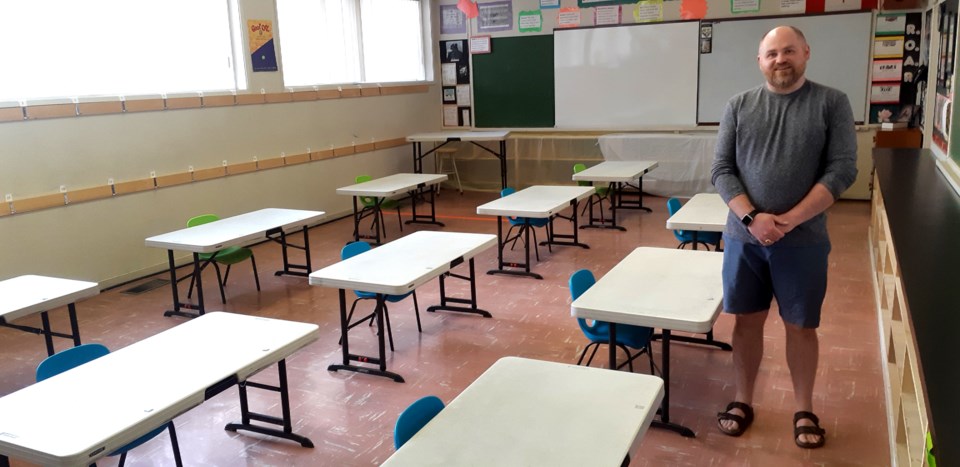Parents of Prince George kindergarten-Grade 7 students should be planning for a five-day-per-week return to school in September.
That full restart for elementary-aged students is the goal Education Minister Rob Fleming has in mind. Fleming said Wednesday, during question period, the province will reveal more details within the next three weeks about its plan for schools to reopen for the upcoming school year.
In his update on Wednesday, Fleming said there’s a certainty that kindergarten-Grade 7 students will be allowed back in the classroom, as they were at the start of June. School schedules over the past month were staggered to minimize crowding and classroom desk configurations were set up to minimize the chance of physical contact.
“We were originally set to believe we wouldn’t hear until late August, but recently the minister has said a plan will be out to parents about what September may look like within a couple of weeks,” said School District 57 chair Tim Bennett.
“The minister did make comments that K-7 parents should be prepared for school to go back full-time, which would indicate we’re going back in at least Stage 2 (of the five-step restart plan) but we won’t know until everything is announced in the coming weeks.”
Stage 3 protocols were in place which allowed for in-class learning to resume two days per week for K-Grade 5 students and one day per week for Grades 6-12. Children of essential service workers were cleared to attend school full-time, five days per week. Those classes were optional and less than 30 per cent of SD 57’s 12,894 students returned for the final month of the school year. Most of the students who did come back for June were in the younger grades.
Stage 3 restrictions mean schools cannot exceed 50 per cent capacity. Bennett said if alternating class schedule times and a lack of space in schools make it impossible to prevent physical contact among the students, then the district might have to look at community halls or other alternatives to find alternate classroom space to allow all students to return to class and keep students and staff safe.
Bennett, as a trustee, has joined other educational stakeholders (teachers, superintendent, principals, support staff and parents) in provincial-level working groups within the district to provide feedback to the ministry which will shape what schools will look like when on the first day of classes, Sept. 8.
“The framework is laid out by the ministry and then the district has to figure out how to operationalize that,” said Bennett.
“Realistically, we’ll probably be at least where we were in June, but hopefully Stage 2 or Stage 1. If the minister comes out and says we’re in Stage 2, which is full-time K-7 and part-time secondary, then the district will have to figure out how to make that happen. If we enter at Stage 1, which is everybody back into the building, we’ll be ready for that as well. We anticipate by August 1st we’ll know what September will look like.”
The sooner that becomes clear, the better, says Joanne Hapke, president of the Prince George District Teachers’ Association. After months of upheaval and uncertainty as teachers made the shift to on-line instruction, she said the nearly 1,000 teachers in the district need as much time as possible to rethink how they will conduct their lessons.
“If we know by the end of July, that would be fabulous because teachers, even though they’re on summer holidays, can start preparing for what the classroom will look like for the very least in September,” said Hapke.
“We all know things could change for October or November but at least we’ll know what to look for when we arrive back to school.”
Hapke is encouraged by the slowing spread of COVID-19 in the province, especially in northern B.C, where no new cases have been discovered in more than month. But over the next two months, with more people traveling and a small trickle of American tourists continuing to come across the border from COVID-19 hotspots in the U.S., she said there’s more likelihood of people coming into contact with the virus and teachers are concerned about a possible second wave coming in the fall. To reduce the threat of transmission, Hapke is hoping schools will maintain vigilant cleaning standards during the coming school year.
“We don’t know what COVID is going to look like and I hope the minster is taking into account the provincial health recommendations and that we aren’t being used to restart the economy,” said Hapke. “We’re going to go into a season of everybody coming together and we all know what the fall is like in a classroom. Everybody shares their viruses after two months of being away from one another.”
Teachers who had been conducting on-line lessons for more than two months were forced by the district to return to schools on June 1st and Hapke considers that a slap in the face of some of her colleagues who didn’t feel safe coming to work.
“If you want teachers to be responsible for something, then there should be some respect for the work we did,” Hapke said. “We truly reorganized our curriculum and the our delivery model in a matter of days and when people were seeking accommodations to allow them to keep working from home and were being told you must be at work, that is not respecting the work that we have done.
“I’m really hopeful that people have more respect for what we are doing and how we are doing it, and that it is seen more in society.”



